| |
|
This page is devoted
to various forms of graphic art treating the subject of the
air war in Nicaragua — mostly editorial cartoons,
along with some propaganda sheets and comic books.
About two dozen examples are included here, though a
systematic search would probably reveal many more; each is
accompanied by a brief descriptive and interpretive caption.
Grateful appreciation is extended to Lebanon Valley College
students Leslie Marie Hiller and Thafany Pamela Luna Minguez
for their translations of some of the captions, and to the
Arnold Grant in Experiential Education for funding their
work.
|
Esta página
se dedica a diversas formas de arte gráfico
que tratan el tema de la guerra aérea en Nicaragua
— en su mayoría caricaturas editoriales, junto con unas
hojas de propaganda y libros de historietas. Cerca de
dos docenas ejemplos se incluyen aquí, pero una búsqueda
sistemática probablemente revelaría muchos más. Cada
dibujo va acompañado de una breve descripción y leyenda
interpretativa. Agradecido aprecio se extiende a
estudiantes Líbano Valley College Leslie Marie Hiller y
Thafany Pamela Luna Minguez por sus traducciones de algunos
de los títulos, y para el Arnold Grant en Educación
Experiencial para financiar su trabajo.
|
|
|
II. Cartoons & Artwork
with Interpretive Captions
|
21 July 1927
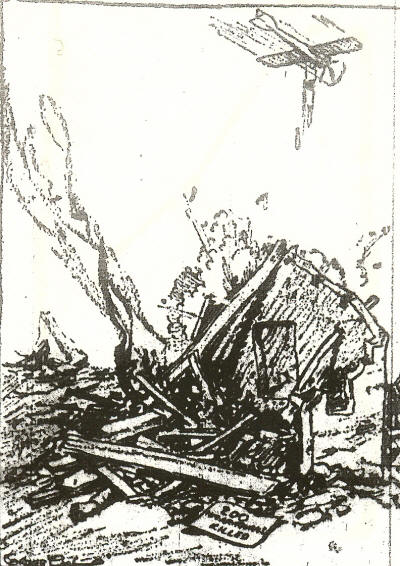
"Another
American Aviation Achievement"
Louisville Courier-Journal, 21 July 1927
Only two months earlier, on 21 May, Charles
Lindbergh had achieved world fame by completing the first solo
flight across the Atlantic. In this era of aviation firsts,
the battle of Ocotal (16 July 1927) was the first time in history
that an air attack was directed by ground forces. Five US Marine DeHaviland biplanes killed
upwards of 300 Nicaraguan attackers, evoking a storm of protest and
condemnation across the Atlantic World and especially in Latin
America. US Marine Captain Gilbert Hatfield's original reports
on the Sandinista assault on Ocotal, along with Sandino's
account of the battle, are transcribed in full in
PC-DOCS 27.07.16 and
PC-DOCS 27.07.20.
Reprinted in the St. Louis Post-Dispatch, 22
July 1927 (sign at the bottom reads "200 Nicaraguans killed").
"Otro logro de la aviación americana"
Sólo
dos meses antes, el 21 de mayo, Charles Lindbergh había
alcanzado la fama mundial al completar el primer vuelo en
solitario a través del Atlántico. En esta era de
innovaciones de la aviación, la batalla de Ocotal (16 de julio
1927) fue la primera vez en la historia que un ataque aéreo
dirigido por las fuerzas de tierra. Cinco de Marines de
EE.UU. biplanos De Havilland mató a más de 300 atacantes de
Nicaragua, que evoca una tormenta de protestas y condenas en
todo el mundo atlántico y, sobre todo en América Latina.
Los informes originales del Capitán Gilbert Hatfield de los
marinos sobre el asalto sandinista en Ocotal, junto con la
cuenta de Sandino de la batalla, se transcriben en su totalidad
en
PC-DOCS 27.07.16 y
PC-DOCS 27.07.20.
Reproducido en el St. Louis Post-Dispatch, 22 de julio
de 1927 (signo en la parte inferior se lee "200 nicaragüenses
muertos").
|
back to
inventory
|
24 July 1927
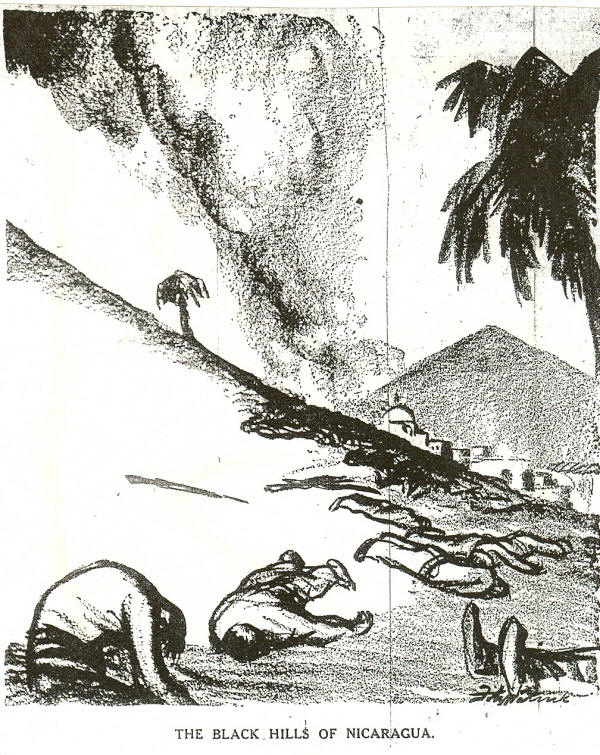
"The
Black Hills of Nicaragua."
St. Louis Post-Dispatch, 24 July 1927.
Representative of the reaction of most of the
Latin American and much of the US and European press to the
battle of Ocotal, the cartoon accurately portrays most rebel
casualties of the bombings as having been killed on the
outskirts of town, with the church and town still intact and the
town smoldering in the background.
"Las
Colinas Negras de Nicaragua."
St. Louis Post-Dispatch, 24 de julio de 1927.
Representante de la reacción de la mayoría de
los Estados de América Latina y gran parte de la prensa
estadounidense y europea a la batalla de Ocotal, la caricatura
retrata con precisión la mayoría de los heridos de los atentados
que han asesinados en las afueras de las ciudades, con la
iglesia y el pueblo ardiendo en el fondo.
|
back to
inventory
|
3 August 1927
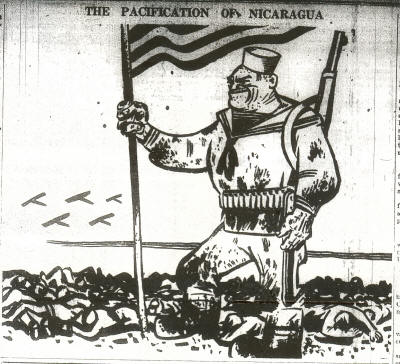
"The
Pacification of Nicaragua."
The Daily Worker, 3 August 1927.
Portraying the US Marines as blood-stained,
monstrous, hyper-masculine brutes taking macabre pleasure in the
slaughter of innocent Nicaraguan civilians, and aided in their
bloodletting by fleets of airplanes, The Daily Worker, organ of
the Workers (Communist) Party of America, ranked among the most
vociferous opponents of US policy in Nicaragua and Latin
America; the paper was also very attentive to issues of race and
gender, domestically and internationally.
"La Pacificación de Nicaragua"
The Daily Worker, 3 de agosto de 1927.
Al presentar a los Marinos de los Estados
Unidos con mancha de sangre, monstruosos, hipermasculinos que
toman placer macabro en la matanza de inocentes civiles
nicaragüenses, y con la ayuda de su sangre por las flotas de
aviones, El Periódico Trabajadores, órgano de los Trabajadores
(Partido Comunista) de los Estados Unidos, se ubica entre los
mas aridentes opositores de la política de los Estados Unidos en
Nicaragua y América Latina: el documento también fue muy atento
a los temas de raza y genero, a nivel nacional e internacional.
|
back to
inventory
|
7 August 1927
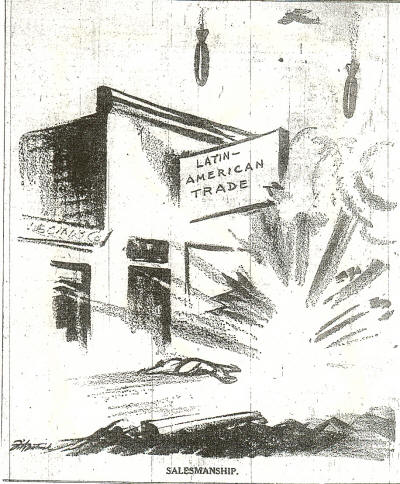
"Salesmanship."
St. Louis Post-Dispatch, 7 August 1927.
Anticipating the upcoming Sixth Pan-American
Conference in Havana (January 1928), the cartoon memorializes
the battle of Ocotal by depicting the United States as
senselessly slaughtering innocent civilians as well as prospects
for improved US-Latin American commercial relations.
"Arte de vender"
St. Louis Post-Dispatch, 7 de agosto de 1927.
Anticipándose a la sexta Conferencia
Panamericana de La Habana (1928 Enero), en la caricatura se
conmemora la batalla de Ocotal al representar a los Estados
Unidos como insensatamente matando a civiles inocentes así como
las perspectivas para mejorar Estados Unidos y América Latina
las relaciones comerciales.
|
back to
inventory
|
5 January 1928
.jpg)
"Unequal, anguished
struggle of Nicaragua can only be waged with the courage of
patriots like Sandino."
Crítica, Buenos Aires, 5 January 1928.
Expressing the sentiments of much of the
Latin American press on the eve of the Pan-American Conference
in Havana, the artist's rendition of the bombing of El Chipote
portrays the Sandinista rebels as courageous patriots fighting
against all odds against the vastly superior power of the US
airplanes. (Source: USDS 817.00/5349; caption reads: "Lucha
desigual, anguistiosa, la de Nicaragua, sólo puede afrontarla el
coraje de los patriotas como Sandino.")
"Lucha desigual,
anguistiosa, la de Nicaragua, solo puede afrontarla el coraje de
los patriotas como Sandino."
Crítica, Buenos
Aires, 5 de enero de 1928.
Expresar los sentimientos de una gran parte
de la prensa latinoamericana en la víspera de la Conferencia
Panamericana de La Habana, la representación artística del
bombardero de El Chipote retrata a los rebeldes sandinistas como
valientes patriotas luchando contra todas las probabilidades
contra el poder inmensamente superior de los aviones de Estados
Unidos.
.jpg)
.jpg)
.jpg)
|
back to
inventory
|
6 January 1928
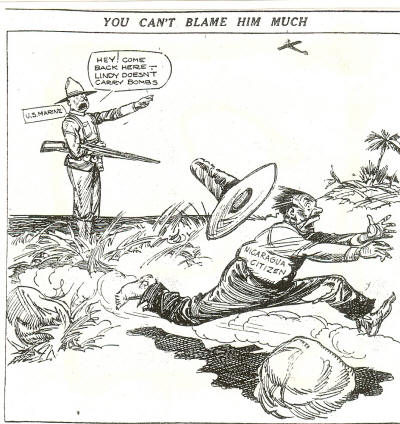
"You Can't Blame Him Much."
The Detroit News, 6 January 1928.
Evoking memories of Ocotal and subsequent
aerial bombardments in Las Segovias, the cartoon ironically
plays off Charles Lindbergh's "goodwill tour" of Latin America.
A few days before, on 2 January, Lindbergh was greeted in San
Salvador by a cheering throng of thousands, while the day after
this cartoon appeared he received a similar reception in
Managua. The cartoon captures the ambiguous imagery of aviation
during this period, the "Nicaraguan citizen" fleeing in mortal
terror from the innocuous airplane.
"No
se puede culpar mucho a él."
The Detroit News, 6 de enero de 1928.
Evocan recuerdos de Ocotal y posterior los
bombardeos aéreos en Las Segovia, irónicamente la caricatura es
de Charles Lindbergh "viaje de buena voluntad" de América
Latina. Pocos días antes, el 2 de enero, Lindbergh fue recibido
en la ciudad de San Salvador por un multitud de miles de
personas, mientras que al día siguiente de esta viñeta apareció
recibió una recepción similar en la ciudad de Managua. La
película de dibujos animados imágenes captura la ambigüedad de
la aviación durante este período, el "ciudadano nicaragüense"
que huye de mortal terror del inocuo avión.
|
back to
inventory
|
6 January 1928
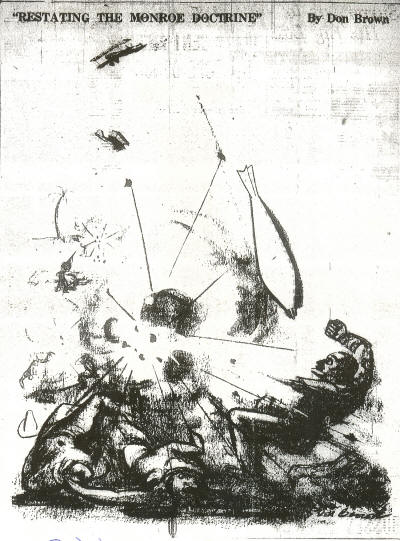
"Restating
the Monroe Doctrine."
The Daily Worker, 6 January 1928.
Offering an updated interpretation of the
Monroe Doctrine, and anticipating the heavy criticism the United
States was likely to receive in Havana, the cartoon's image of
total destruction and senseless victimization is similar to the
images published in the wake of the battle of Ocotal six months
earlier (see above). Significantly, this is the only such
artwork encountered that portrays a woman victimized in the
Marines' aerial campaign (in keeping with its attention to women
and gender, two weeks later, on 20 January, the same newspaper
carried the headline, "Marines Bomb Two Women; Sandino Defies
Wall Street").
.jpg)
"Reafirmando la doctrina Monroe"
The Daily Worker, 6 de enero de 1928.
Ofrece una interpretación actualizada de la
Doctrina Monroe, y adelantarse a las fuertes críticas los
Estados Unidos es probable que reciba en La Habana, la imagen de
la tira cómica de la destrucción total y absurda victimización
es similar a las imágenes publicadas a raíz de la batalla de
Ocotal seis meses antes (ver arriba). Significativamente, este
es la única obra que retrata a una mujer víctima de los Marines
de la campaña aérea (en consonancia con su atención a la mujer y
el género, dos semanas más tarde, el 20 de enero, el mismo
periódico decía: "Marines Bomba dos mujeres; Sandino desafía
Wall Street").
|
back to
inventory
|
7 January 1928
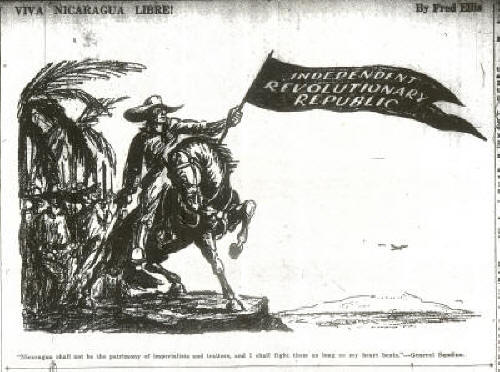
"Viva Nicaragua Libre!"
Fred Ellis, The Daily Worker, 7 January 1928.
Portraying Sandino and his followers as
genuine revolutionaries struggling to establish a truly
independent republic in Nicaragua, this dignified, almost regal
depiction conveys an image of righteous patriotic defiance, and
resembles some of the artwork of the US revolutionary era.
It is noteworthy that the cartoonist, Fred Ellis, does not
presume to speak for Sandino or his followers, instead quoting
him directly ("Nicaragua shall not be the patrimony of
imperialists and traitors, and I shall fight them as long as my
heart beats"). Also noteworthy are the airplanes, symbols
of US imperialist aggression, hovering ominously in the
distance.
.jpg)
"Viva
Nicaragua Libre!"
Fred Ellis, The Daily Worker, 7 de enero de 1928.
Retratar a Sandino y sus seguidores como
auténticos revolucionarios luchan por establecer una república
independiente en Nicaragua, esta representación digna, casi
rejal transmite una imagen de justa rebeldía patriótica y se
asemeja a algunas de las ilustraciones de la época
revolucionaria de Estados Unidos. Cabe destacar que el
caricaturista, Fred Ellis, no te atrevas a hablar por Sandino o
sus seguidores, en cambio le citando directamente ("Nicaragua no
será el patrimonio de los imperialistas y traidores, y les
lucharé mientras mi corazón late"). También son
destacables los aeroplanos, símbolos de la agresión imperialista
de Estados Unidos, cernido siniestramente en la distancia.
|
back to
inventory
|
9 January 1928
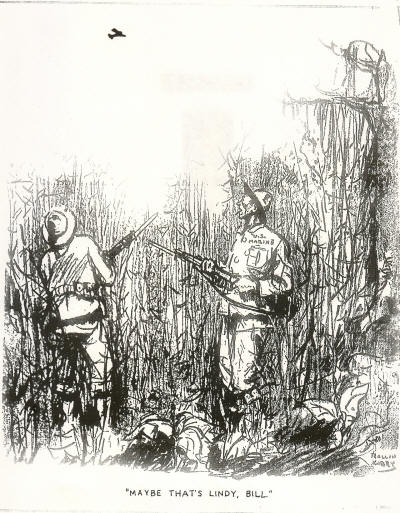
"Maybe That's Lindy, Bill."
Rollin Kirby, St. Louis Post-Dispatch, 9 January 1928.
On the eve of the Sixth Pan-American
Conference in Havana, the St. Louis Post-Dispatch offered yet
another play on the disjuncture between Lindy's "goodwill tour"
and the US use of airpower and amply-armed ground forces in
suppressing the Sandino rebellion. Yet compared to many
portrayals of the Marines, here they are depicted as ordinary
men, surrounded by high brush, in unfamiliar terrain, their
vision obscured, and not really sure what the situation is. (I
touched up the airplane and caption; in the copy I made from
microfilm, these were too faded to see.)
"Tal
vez es Lindy, Bill."
Rollin Kirby, St. Louis Post-Dispatch, 9 de enero de
1928.
En la víspera de la sexta Conferencia
Panamericana en la Habana, el St. Louis Post-Dispatch ofreció
otro juego de los disyuntores entre gira de Lindy "buena
voluntad" y el uso de Estados Unidos de poderío aéreo y las
fuerzas de tierra armada ampliamente en la supresión de la
rebelión de Sandino. Sin embargo, en comparación con muchas
representaciones de los Marines, aquí ellos son representados
como hombres ordinarios, rodeados de cepillo de alta, en un
terreno desconocido, su visión oscura y no estoy muy seguro que
la situación es. (Toqué el aeroplano y el título, en la copia
que hice desde el microfilm, éstos fueron también desapareció
para ver).
|
back to
inventory
|
12 January 1928
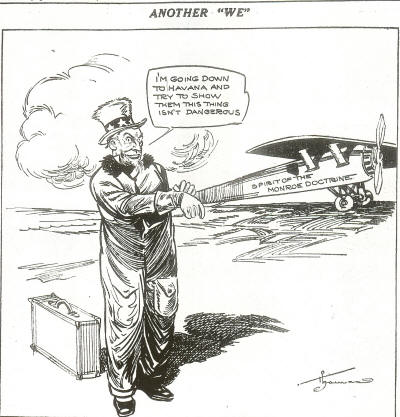
"Another 'We'."
The Detroit News, 12 January 1928.
As Uncle Sam readies to depart for the Havana
conference aboard the "Spirit of the Monroe Doctrine," the
unlikely confluence of three events — the Pan-American
Conference, Lindbergh's "goodwill tour," and the aerial violence
in Las Segovias — is once again highlighted. The cartoon's
title — "Another 'We'" — is a play on Charles Lindbergh's
best-selling memoir, titled We (1927, meaning Lindbergh
& the Spirit of St. Louis fused together). Thanks
to Brian Horrigan of the University of Minnesota for clarifying
the caption's intended meaning.
"Otro 'Nosotros'."
The Detroit News, 12 de enero de 1928.
Como Tío Sam se prepara para salir de la
conferencia de La Habana a bordo del "Espíritu de la Doctrina
Monroe", el improbable confluencia de tres eventos — la
Conferencia Panamericana, Lindbergh y su "viaje de buena
voluntad", y la violencia aérea en Las Segovias — es una vez más
destacado. El título del dibujo — "Otro" 'Nosotros'" — es
un juego de memoria best-seller de Charles Lindbergh,
titulado Nosotros (1927, lo que significa a
Lindbergh y el Espíritu de St. Louis fusionados).
Gracias a Brian Horrigan de la Universidad de Minnesota para
aclarar el significado deseado del subtítulo.
|
back to
inventory
|
16 January 1928
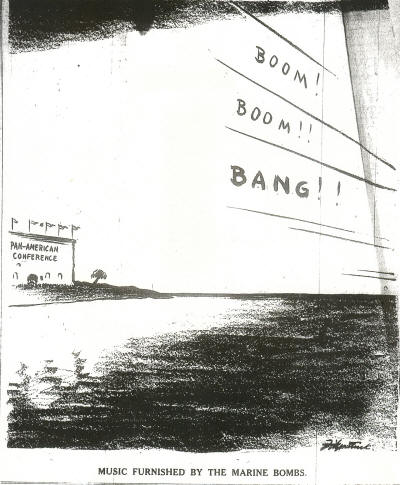
"Music Furnished by the Marine Bombs."
The Daily Worker, 16 January 1928
Same themes, with the Marine airplanes' bombs
providing music for the Havana conference. The planes themselves
are not depicted; the artist presumed that readers would know
where the bombs were coming from.
"La
música proporcionada por las bombas marinas"
The Daily Worker, 16 de enero de 1928.
Los mismos temas, con bombas de los aviones
de la Marina proporcionaban música para la Conferencia de la
Habana. Los aviones de ellos no están representados; el artista
se presume que los lectores sabrían de dónde venían las bombas.
|
back to
inventory
|
17 January 1928
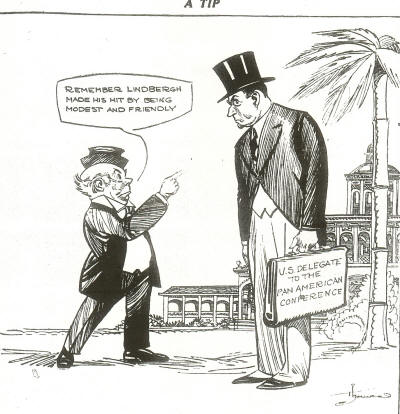
"A
Tip."
The Detroit News, 17 January 1928.
Included here because it references
Lindbergh's "goodwill tour" of Latin America and the
just-beginning Havana Conference, the cartoon includes an odd-looking businessman-cum-Uncle Sam (or not), a sour-faced
US delegate (actually Charles Evans Hughes), and a heavy-handed
punch line.
"Un consejo."
The Detroit News, 17 de enero de 1928.
Incluido aquí por las referencias del "viaje
de buena voluntad" de Lindbergh de América Latina y el
acaba de empezar Conferencia de La Habana, la historieta incluye
un empresario-cum-Tío Sam (o no) de aspecto extraño, la cara
agria del delegado
norteamericano (en realidad Charles Evans Hughes), y un frase
clave torpe.
|
back to
inventory
|
18 January 1928
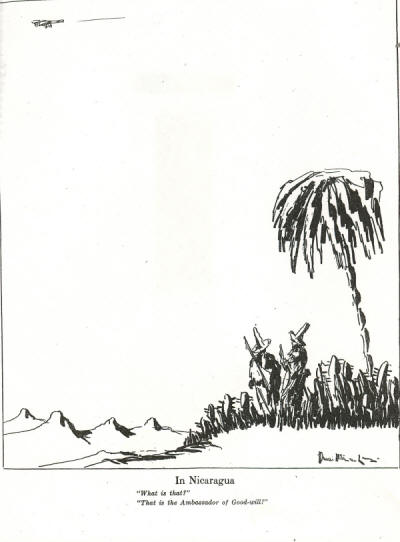
"In
Nicaragua. 'What is that?' 'That is the Ambassador of
Good-will!'"
The Nation, 18 January 1928.
With two armed Nicaraguan rebels pondering
the strange apparition in the sky, The Nation offers yet another
pointed criticism of US hypocrisy in Latin America just as the
Sixth Pan-American Conference was getting underway in Havana.
.jpg)
.jpg)
""En
Nicaragua. '¿Qué es esto?' '¡Esto es el Embajador de
Buena voluntad!'"
The Nation, 18 de enero de 1928.
Con dos rebeldes nicaragüenses armados que
consideran la aparición extraña en el cielo, La Nación ofrece
una otra crítica puntiaguda de la hipocresía estadounidense en
América Latina como la Sexta Conferencia panamericana se ponía
en curso en La Habana.
|
back to
inventory
|
19 January 1928
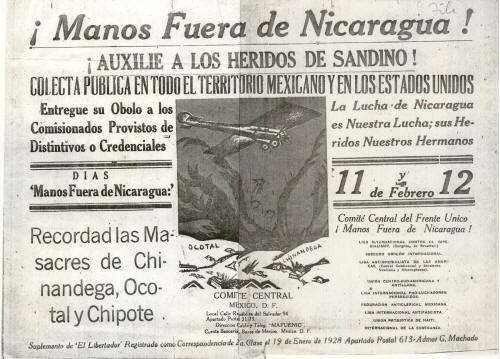
.jpg)
"Hands Off Nicaragua! Aid to Sandino's Wounded!"
Supplement to El Libertador, Mexico City, 19 January
1928.
(two views)
In this propaganda broadsheet of the Hands
Off Nicaragua Committee, the oversized US airplane conveys an
image of overwhelming power, while the smoldering landscape
evokes a sense of wanton massacre and total destruction.
Significantly, the US Marines never bombed Chinandega (though
two private US mercenaries did, at the behest of Conservatives,
in February 1927, during the Nicaraguan Civil War, though they
did almost no damage). Translation: "Aid to Sandino's Wounded!
Public Collection in the Entire Mexican Territory and in the
United States. ... Nicaragua's Struggle Is Our Struggle; its
Wounded Our Brothers ... Remember the Massacres of Chinandega,
Ocotal, and Chipote ..." Source: NA127/220/1/839. I am grateful
to David C. Brooks for providing a copy of this broadside.
"Manos
Fuera de Nicaragua! ¡Auxilie a los heridos de Sandino!"
Suplemento de El Libertador, Ciudad de México, 19 de
enero 1928.
(dos vistas)
En este periódico de propaganda del Comité
Manos Fuera de Nicaragua, el avión estadounidense
sobredimensionado transmite una imagen de poder abrumador,
mientras que el ardiente paisaje evoca un sentido de masacre
indiscriminada y la destrucción total. Significativamente, los
Marines nunca bombardearon a Chinandega (aunque dos mercenarios
privados de Estados Unidos hicieron, a instancias de los
conservadores, en febrero de 1927, durante la Guerra Civil
nicaragüense, aunque no hicieron casi ningún daño).
Fuente: NA127/220/1/839. Agradezco a David C. Brooks para
proporcionar una copia de esta andanada.
|
back to
inventory
|
24 January 1928
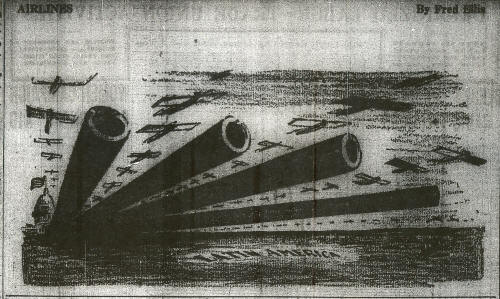
"Airlines."
Fred Ellis, The Daily Worker, 24 January 1928.
Conveying the interpretation of the Worker's
(Communist) Party of America, the Anti-Imperialist League, and
many other left-leaning organizations of the late 1920s, the
cartoon portrays the United States as a mighty behemoth
determined to dominate and control Latin America by brute force,
represented here by massive cannons and an endless fleet of
airplanes emanating from the Capitol Building in Washington D.C.
"Aerolíneas"
Fred Ellis, The Daily Worker, 24 de enero 1928.
Transmitir la interpretación del Partido
Trabajador (Comunista) de América (del Norte), la Liga Antimperialista, y
muchas otras organizaciones izquierdistas de los últimos años del
decenio de 1920, el cómic retrata los Estados Unidos como un
poderoso gigante decidido a dominar y controlar América Latina
por medio de la fuerza, en este caso representada por enormes
cañones y un interminable flota de aviones procedentes de el
Edificio del Capitolio en Washington D.C.
|
back to
inventory
|
25 January 1928
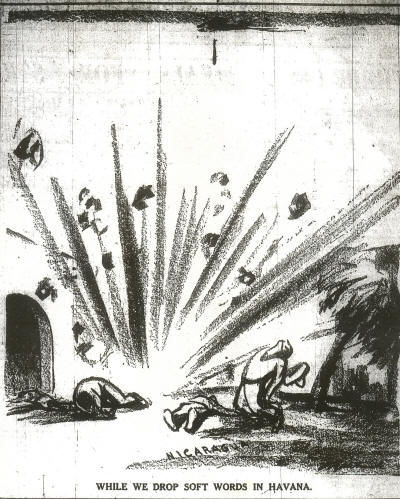
"While
We Drop Soft Words In Havana."
St. Louis Post-Dispatch, 25 January 1928.
Compared to The Detroit News cartoon
of the same date (below), this illustration conveys a similar
sense of US-produced aerial terror and senseless victimization,
while its depiction of the wounded and dead offers a more
pointed and direct criticism of the hypocrisy of US Latin
America policy.
""
|
back to
inventory
|
25 January 1928
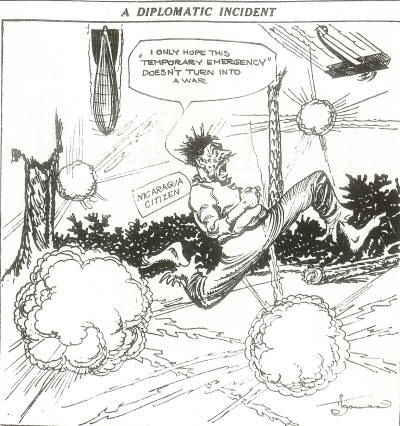
"A Diplomatic Incident."
The Detroit News, 25 January 1928.
Portraying a terrified "Nicaragua citizen"
expressing his hope that "this 'temporary emergency' doesn't
turn into a war," the cartoon pokes fun at the euphemisms used
by US policymakers, highlighting the popular perception that US
policy in Nicaragua was at core hypocritical.
""
|
back to
inventory
|
25 January 1928
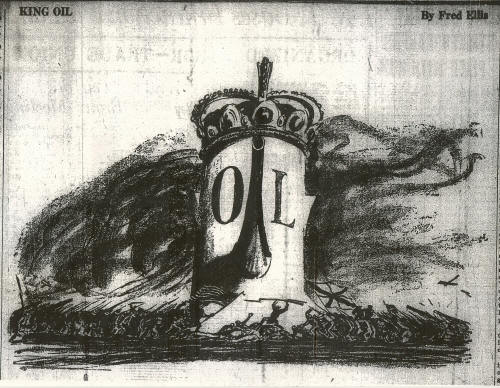
"King Oil."
Fred Ellis, The Daily Worker, 25 January 1928.
With airplanes hovering in the distance
(lower right), the cartoon draws a direction connection between
US military ventures overseas and the interests of the US
petroleum industry.
""
|
back to
inventory
|
24 February 1928
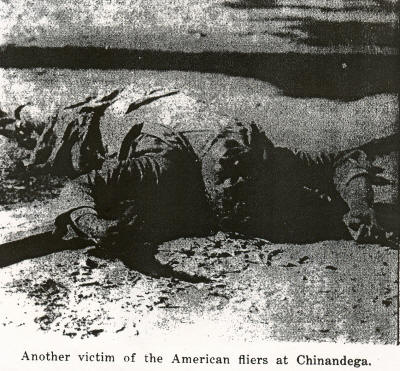
"Another
Victim of the American Fliers at Chinandega."
All-American Anti-Imperialist League, 24 February 1928.
In this detail from a propaganda pamphlet of
the All-American Anti-Imperialist League, a man portrayed as a
victim of US imperialist aggression lies dead on the street. As
noted above, the US Marines never bombed Chinandega, though two
US mercenary pilots did, causing very little damage.
""
|
back to
inventory
|
7 March 1928
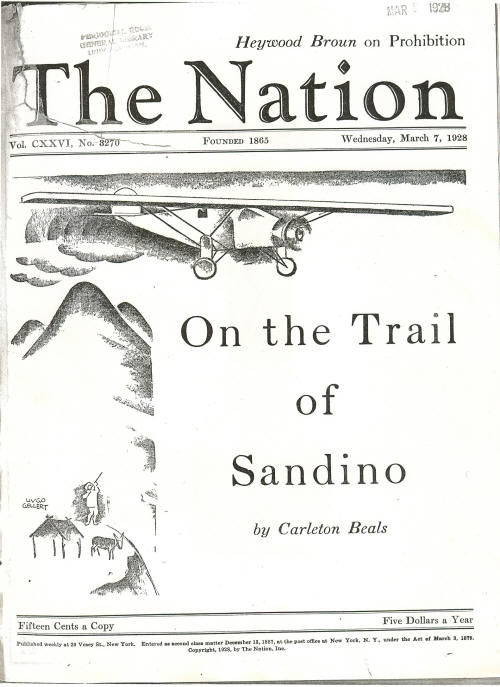
"On the Trail of Sandino."
Hugo Calvert, cover of The Nation, 7 March 1928.
In an ambiguous image, the oversized airplane
conveys US imperial might, while its fragile appearance and lack
of aggressive behavior conveys weakness and vulnerability. The
man on the ground, standing beside his mule and hut and taking
careful aim at the plane, evokes not victimization but defiance,
resistance, and righteous defense of his home and property. The
mule's lack of concern, and the simplicity of the surroundings,
suggest that such defense is a simple, uncomplicated, easily
understandable act. This issue of The Nation launched Carleton
Beals' famous series of articles on the Sandino rebellion,
including his interviews with Sandino -- the only US journalist
to interview the guerrilla chieftain.
.jpg)
""
|
back to
inventory
|
June-July 1976
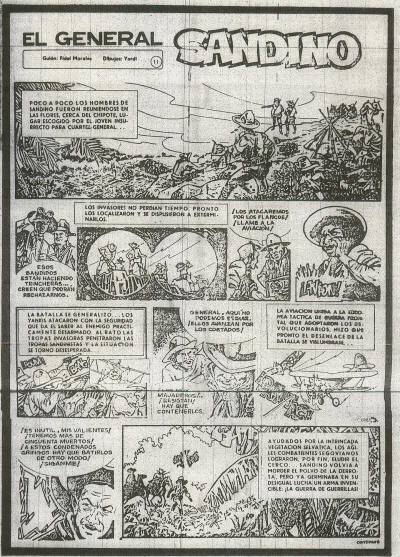
"El
General Sandino," No. 11
Script by Fidel Morales, drawings by Yordi
Prisma del Meridiano 80 (nos. 26-28), Cuba, June-July
1976
Reprinted in Barricada, Managua, 12 Feb 1980
In this comic book version of Sandino's fight
against the Marines, published in Cuba three years before the
triumph of the Sandinista Revolution in 1979, and 48 years after
the event, the "unequal fight" against Marine Corps airplanes on
El Chipote causes the deaths of more than fifty rebels,
compelling Sandino to retreat, melt into the jungle, and rethink
his tactics, from which evolved the "war of guerrillas."
Below appear close-ups of the two panels
showing airplanes (of poor quality because we are looking at a
reprint of a reprint of a reprint, but accurate in that all are
biplanes similar in shape and size to the Corsairs and Curtiss
Falcons actually used against the rebels at El Chipote; the
Marine pilots reported seeing at least 45 dead rebels, as seen
in the
original report):
.jpg)
[Marines:] "We'll attack them by the flanks!
Call in the airplanes!
[Sandinista:] "A I R P L A N E !"
.jpg)
"The battle became generalized . . . the
Yankees attacked with the security of knowing their enemy was
practically unarmed. Soon the invading troops were on top of the
Sandinista troops and the situation turned desperate . . . "
.jpg)
"It's useless, my valiant ones! We have
more than fifty dead! We have to fight those accursed
gringos another way! Follow me!"
.jpg)
"The aeroplanes used the [resounding] tactic
of frontal warfare that the revolutionaries had adopted, and
soon all could see that the battle was lost."
In the last panel, the surviving Sandinistas
melt back into the jungle, and from this defeat Sandino would
develop "an invincible weapon: ¡la guerra de guerrillas!" --
guerrilla war.
""
|
back to
inventory
|
7 August 1983
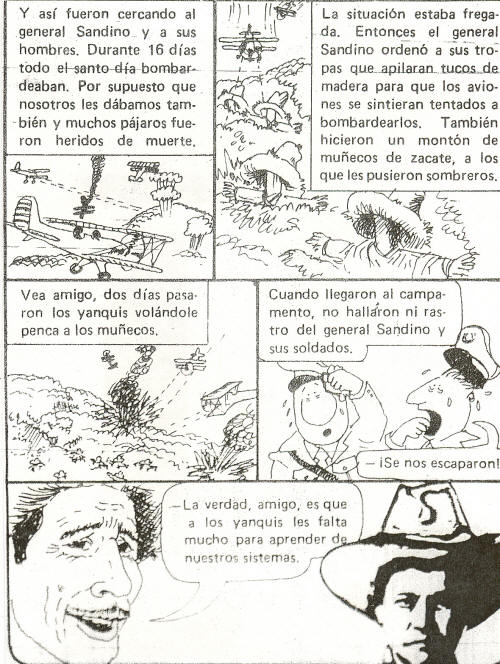
Excerpt of a Serial Graphic History of Sandino's Rebellion
7 August 1983
Barricada, Managua
Excerpt of a serial graphic history of the
Sandino rebellion, featuring Sandino's famous "men of grass"
feint on El Chipote in mid-January 1928, published in the
official daily organ of the FSLN during a period of intensifying
conflict with the Reagan administration. In these panels,
US planes spend "16 days all blessed day long bombing. Of
course we got them too and many birds were mortally wounded."
Sandino orders his troops to build grass dummies; the planes
foolishly attack the fake soldiers; the Marines, sweating
profusely and scratching their heads like morons, are shocked at
Sandino's escape. The grinning, crinkly-eyed narrator, a
wise and seasoned campesino, remarks, "The truth, my friend, is
that the Yankees have a lot to learn about our own systems" --
giving contemporary voice to Sandino's comment at the time -- as
the heroic rebel chieftain's steely-eyed visage lends silent
authority to the campesino's comment.
""
|
back to
inventory
|
9 October 1983
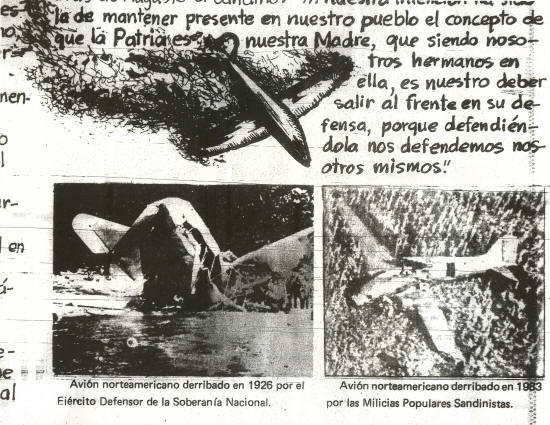
North American Airplane downed in 1926 [and] in 1983.
Barricada, 9 October 1983 (fragment)
Appearing two months after "An Inspired
Deception," this cartoon-photo composite seeks to establish a
direct connection between Sandino's fight against the Marines in
the 1920s and 1930s and the FSLN's ongoing conflict with the
Reagan administration and the Contras. The intended
message is unambiguous: two planes, two different periods, but
the same struggle against US imperialist aggression. (It
is noteworthy that Sandino's Defending Army was founded in
September 1927, and that Sandino's forces downed its first US
plane in July 1927 -- not 1926, as noted here.)
""
|
back to
inventory
HIGH-RESOLUTION ILLUSTRATIONS:
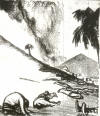 |
1. Black Hills of Nicaragua -
St Louis Post-Dispatch |
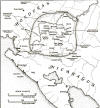 |
2.
Map of Las Segovias |
_small.jpg) |
3.
Map of Las Segovias and adjacent zones, showing airfields
built 1927-1934; adapted from US Army Map, Geographic Intelligence,
Military Intelligence Division (G-2), 1934 |
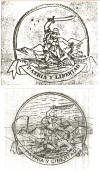 |
4.
Sandino seals |
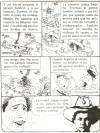 |
5.
Inspired Deception, Barricada |
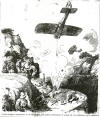 |
6.
Critica, Buenos Aires, Jan 1928 |
 |
7.
The Daily Worker |
 |
8.
Hands Off Nicaragua Committee broadside |
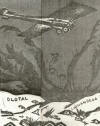 |
9.
Hands Off Nicaragua Committee, detail of broadside |
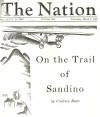 |
10.
The Nation - detail of cover |
| |
Top of Page
|
|
|

